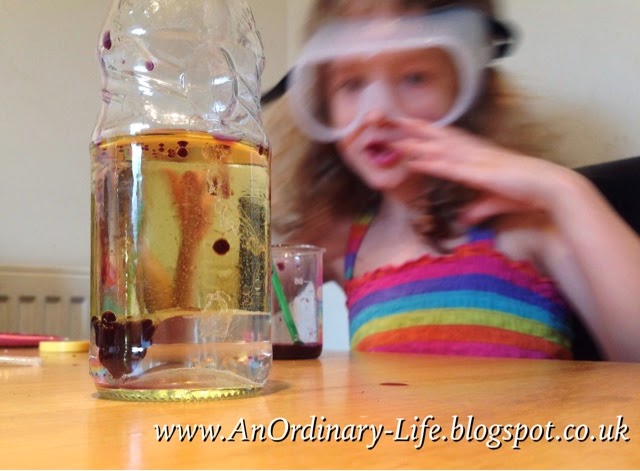
A great experiment to try for all the family and teaches us about some interesting science too!
You will need:
- A clear glass bottle
- Water
- Oil - we used vegetable oil
- food colouring
- A funnel
- An fizzy antacid tablet or, like us, a fizzy vitamin C tablet
STEP ONE
Fill your bottle with about 4cm high of water.
STEP TWO
Using your funnel pour in 100ml of oil
STEP THREE
Add 10 drops of food colouring to your bottle. This part is fun to watch! You can read more about it later in this post.
STEP FOUR
Now for the exciting part!
Add quarter or half a fizzing tablet to bottle.
Add quarter or half a fizzing tablet to bottle.
So what
is happening?
When we
add the oil we don't have to worry about the oil and the water mixing because
they won't.
Why? Because oil
is hydrophobic, which means that it hates water. To explain it
simply: All the tiny oil particles are so scared of the water they keep moving
away from the water molecules and that's why they don't mix.
The reason that the oil sits on
the top rather than underneath is simply that water is denser (Density
means has more mass/weighs more per cm squared) than oil does.
You would have also noticed that
when we add the droplets of food colouring, they fall slowly through the
oil and then sit at the bottom of the oil for a time before exploding.
This is because the oil coats the drops of food colouring and it's not
until the wall of oil is broken through that the food colouring escapes and
mixes with the water underneath making it a pretty colour!
When we
added the fizzy tablet, you will notice that it didn't react until it reached
the water. This is because it
is the chemical reaction between the tablet and the water that
creates the fizz; it forms a gas called carbon dioxide.
It is these bubbles of carbon
dioxide (CO2) that catch some of the food coloured water and carries it
back up through the oil. The reason the bubbles still go up even though
they are filled with water is because the density of the carbon dioxide
bubbles filled with water is less dense than both water and the oil, so it
floats right up to the top.
When these bubbles filled with
gas and coloured water reach the surface of the oil they pop, releasing
the gas into the air and causing the water to fall back down again to the
bottom! Thus, giving an effect like the lava lamps.

No comments:
Post a Comment